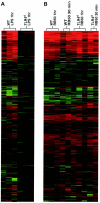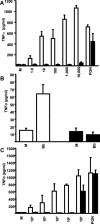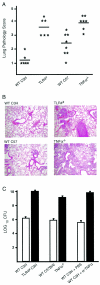Toll-like receptor 4-dependent early elicited tumor necrosis factor alpha expression is critical for innate host defense against Bordetella bronchiseptica
- PMID: 15501798
- PMCID: PMC523027
- DOI: 10.1128/IAI.72.11.6650-6658.2004
Toll-like receptor 4-dependent early elicited tumor necrosis factor alpha expression is critical for innate host defense against Bordetella bronchiseptica
Abstract
Toll-like receptor 4 (TLR4) mediates the response to lipopolysaccharide, and its activation induces the expression of a large number of inflammatory genes, many of which are also induced by other pathogen-associated molecular patterns. Interestingly, the subset of genes that are dependent on TLR4 for optimal expression during gram-negative bacterial infection has not been determined. We have previously shown that TLR4-deficient mice rapidly develop acute pneumonia after inoculation with Bordetella bronchiseptica, suggesting that TLR4 is required for expression of early elicited gene products in this model. Microarray analysis with macrophages derived from wild-type and TLR4-deficient mice was used to identify genes whose expression, within 1 h of bacterial exposure, is dependent on TLR4. The results of this investigation suggest that TLR4 is not required for the majority of the transcriptional response to B. bronchiseptica. However, early tumor necrosis factor alpha (TNF-alpha) mRNA expression is primarily dependent on TLR4 and in vitro and in vivo protein levels substantiate this finding. TLR4-deficient mice and TNF-alpha-/- mice are similarly susceptible to infection with relatively low doses of B. bronchiseptica and in vivo neutralization studies indicate that it is the TLR4-dependent early elicited TNF-alpha response that is critical for preventing severe pneumonia and limiting bacterial growth. These results suggest that one critical role for TLR4 is the generation of a robust but transient TNF-alpha response that is critical to innate host defense during acute gram-negative respiratory infection.
Figures






Similar articles
-
Comparative toll-like receptor 4-mediated innate host defense to Bordetella infection.Infect Immun. 2005 Dec;73(12):8144-52. doi: 10.1128/IAI.73.12.8144-8152.2005. Infect Immun. 2005. PMID: 16299309 Free PMC article.
-
Toll-like receptor 4 is critical to innate host defense in a murine model of bordetellosis.J Infect Dis. 2004 Mar 1;189(5):833-6. doi: 10.1086/381898. Epub 2004 Feb 17. J Infect Dis. 2004. PMID: 14976600
-
Toll-like receptor 4 limits transmission of Bordetella bronchiseptica.PLoS One. 2014 Jan 30;9(1):e85229. doi: 10.1371/journal.pone.0085229. eCollection 2014. PLoS One. 2014. PMID: 24497924 Free PMC article.
-
Toll-like receptor 4-positive macrophages protect mice from Pasteurella pneumotropica-induced pneumonia.Infect Immun. 2003 Feb;71(2):663-70. doi: 10.1128/IAI.71.2.663-670.2003. Infect Immun. 2003. PMID: 12540543 Free PMC article.
-
Environmental sensing mechanisms in Bordetella.Adv Microb Physiol. 2001;44:141-81. doi: 10.1016/s0065-2911(01)44013-6. Adv Microb Physiol. 2001. PMID: 11407112 Review.
Cited by
-
Use of a genetically defined double mutant strain of Bordetella bronchiseptica lacking adenylate cyclase and type III secretion as a live vaccine.Infect Immun. 2007 Jul;75(7):3665-72. doi: 10.1128/IAI.01648-06. Epub 2007 Apr 23. Infect Immun. 2007. PMID: 17452472 Free PMC article.
-
Comparative toll-like receptor 4-mediated innate host defense to Bordetella infection.Infect Immun. 2005 Dec;73(12):8144-52. doi: 10.1128/IAI.73.12.8144-8152.2005. Infect Immun. 2005. PMID: 16299309 Free PMC article.
-
Constraint-based network model of pathogen-immune system interactions.J R Soc Interface. 2009 Jul 6;6(36):599-612. doi: 10.1098/rsif.2008.0363. Epub 2008 Oct 24. J R Soc Interface. 2009. PMID: 18952547 Free PMC article.
-
Role of the type III secretion system in a hypervirulent lineage of Bordetella bronchiseptica.Infect Immun. 2009 Sep;77(9):3969-77. doi: 10.1128/IAI.01362-08. Epub 2009 Jul 13. Infect Immun. 2009. PMID: 19596779 Free PMC article.
-
Bordetella pertussis pathogenesis: current and future challenges.Nat Rev Microbiol. 2014 Apr;12(4):274-88. doi: 10.1038/nrmicro3235. Epub 2014 Mar 10. Nat Rev Microbiol. 2014. PMID: 24608338 Free PMC article. Review.
References
-
- Beutler, B., K. Hoebe, X. Du, and R. J. Ulevitch. 2003. How we detect microbes and respond to them: the Toll-like receptors and their transducers. J. Leukoc. Biol. 74:479-485. - PubMed
-
- Chapes, S. K., D. A. Mosier, A. D. Wright, and M. L. Hart. 2001. MHCII, Tlr4, and Nramp1 genes control host pulmonary resistance against the opportunistic bacterium Pasteurella pneumotropica. J. Leukoc. Biol. 69:381-386. - PubMed
-
- Chow, J. C., D. W. Young, D. T. Golenbock, W. J. Christ, and F. Gusovsky. 1999. Toll-like receptor-4 mediates lipopolysaccharide-induced signal transduction. J. Biol. Chem. 274:10689-10692. - PubMed
-
- DeForge, L. E., J. S. Kenney, M. L. Jones, J. S. Warren, and D. G. Remick. 1992. Biphasic production of IL-8 in lipopolysaccharide (LPS)-stimulated human whole blood: separation of LPS- and cytokine-stimulated components using anti-tumor necrosis factor and anti-IL-1 antibodies. J. Immunol. 148:2133-2141. - PubMed
Publication types
MeSH terms
Substances
Grants and funding
LinkOut - more resources
Full Text Sources
Molecular Biology Databases

